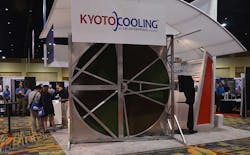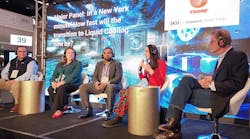As more data centers embrace indirect air cooling, two cooling vendors specializing in the technology are headed to court in a patent dispute.
At the heart of the dispute is a heat wheel, a heat exchange system which is gaining traction in data centers after years of use in other industries.
Air Enterprises, which licenses an implementation for data centers known as Kyoto Cooling has filed suit claiming that rival cooling vendor Nortek Air Solutions infringed on its patents.
The two companies recently competed to win a contract to provide indirect evaporative cooling (IDEC) products for a new data center design for Equinix, the world’s largest operator of colocation data centers. Nortek won the contract, only to have Air Enterprises file a lawsuit, asserting that Nortek’s indirect cooling unit, known as Cool3, contained a heat wheel that infringed upon its patents.
“Air Enterprises is the exclusive licensee of KyotoCooling’s technology in the United States, and as such, we feel it necessary to vigorously protect our rights when competitors offer infringing heat wheel solutions,” said Joe Miketa, CEO of Air Enterprises.
Air Enterprises licenses the technology from the U.S. unit of KyotoCooling BV, a firm based in the Netherlands that owns patents on the system in the U.S., Europe and China. The heat wheel – also known as a rotary heat exchanger – is a refinement of existing approaches that take advantage of outside air to improve cooling efficiency and reduce data center power bills.
“Nortek offered its Indirect Evaporative Cooling (“IDEC”) Unit for Datacenters, along with conventional refrigerant-based cooling equipment, in a configuration that infringes the patent
claims involved in this action,” Air Enterprises states in its lawsuit.
Nortek Denies Infringement
NorTek, which has provided custom cooling solutions for many leading data center providers, denied that it has infringed on the patents of Air Enterprises or KyotoCooling.
The NorTek Cool 3 indirect evaporative cooling unit is at the heart of a legal dispute bwteen NorTek and AirEnterprises, which license the KyotoCooling “heat wheel” technology. (Photo: NorTek)
“Their lawsuit is without merit,” said Mark DeVincent, President of Nortek Air Solutions. “It indicates that Air Enterprises and KyotoCooling do not understand the unique technology employed by Nortek Air Solutions Cool3 IDEC unit.”
DeVincent said the product was developed based on heat recovery technology used in earlier versions of the company’s cooling systems.
“Our many customers have benefited from over thirty years of our expertise in heat recovery products and other commercial and custom heating, ventilation and air conditioning (HVAC) products, including in mission critical applications such as data centers, healthcare facilities and high tech manufacturing.”
Used in 100 Data Centers
In its lawsuit, Air Enterprises alleges that NorTek has infringed U.S. Patent No. 7,753,766, which covers “innovative uses of heat wheels to cool data centers.” The plaintiffs allege that NorTek infringed upon claim 1 of its patent, which reads:
A data center, comprising: an air humidity- and temperature-conditioned space in a building where heat producing ICT and/or telecom equipment is arranged, the ICT and/or telecom equipment having an operating temperature; a primary data center cooling means, the primary data center cooling means comprising a substantially sensible only heat exchange heat wheel cooling a first re-circulated air stream heated by the equipment to a cooling temperature at or below the operating temperature using a second separate airstream at a temperature less than or equal to the cooling temperature minus a predetermined temperature difference without any additional cooling device, the primary data center cooling means comprising no refrigerant or liquid-based cooling; and a secondary data center cooling means supplementing the primary data center cooling means when the second air stream is at a temperature greater than the cooling temperature minus the predetermined temperature difference to cool the first re-circulated air stream to the cooling temperature, wherein the primary data center cooling means is configured to cool the first re-circulated air stream to the cooling temperature without any additional cooling device whenever the second air stream temperature is less than or equal to the cooling temperature minus the predetermined temperature difference.
KyotoCooling says its technology is now installed in more than 100 data centers worldwide, including facilities for Hewlett Packard Enterprise, United Airlines, Bell Canada and Bend Broadband.
Indirect evaporative cooling has been growing in popularity within the data center industry. Compass Datacenters recently introduced a new data center design which will feature KyotoCooling units.






